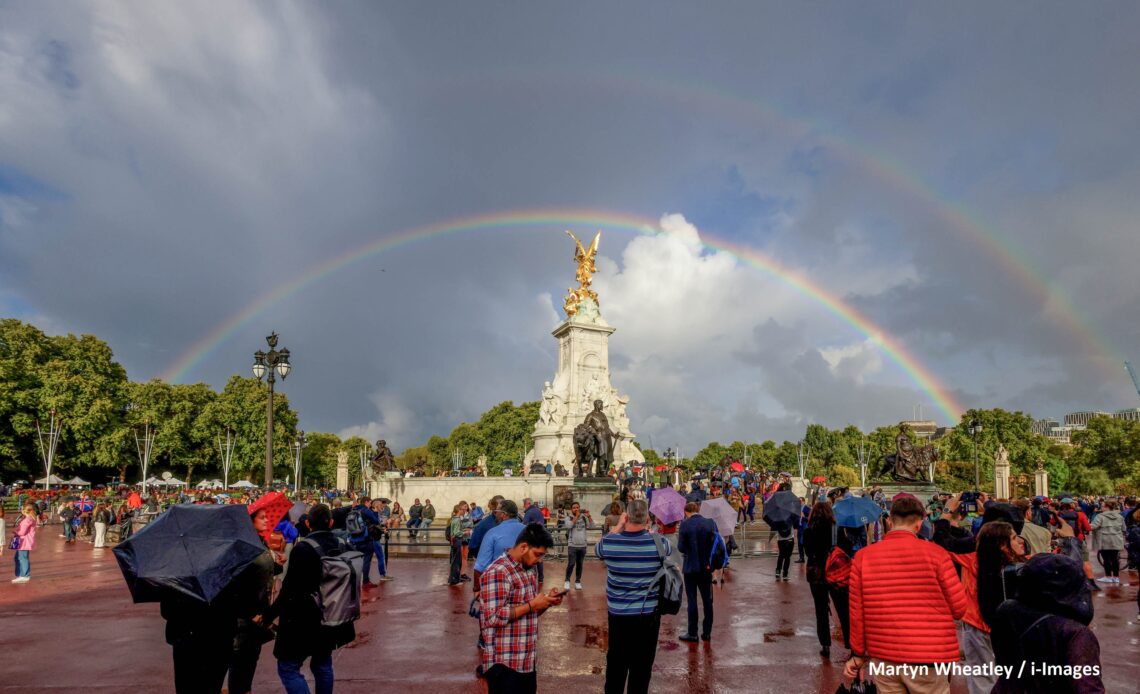
In the days between the death of Queen Elizabeth II and Her Late Majesty’s State Funeral, the country she had ruled for seventy years went into national mourning. And amidst the week and a half of ceremonial and constitutional events came some moments that would mark the passing of a Monarch.
Amongst the most striking symbols of that strange time was the rainbow. As Buckingham Palace announced that Queen Elizabeth II’s health was giving cause for concern, the skies above her capital city of London darkened and the rains fell. Nothing unusual there, it was September. The dampness didn’t stop thousands gathering at the Palace as the wait for news continued. Just before the flag was lowered to half mast and the simple death announcement came, a rainbow blazed its way across the now blue sky outside the Palace. It sat above the monument to Queen Victoria, supplanted as the longest reigning monarch in British history by the great, great granddaughter whose own passing was about to be confirmed.
And then, within moments, a second arc of colour grew next to the original. A rare, double rainbow, right there, at the place so synonymous with Queen Elizabeth II. As if to underline the strangeness of that unexpected and yet inevitable day, another appeared above the Round Tower at Windsor Castle, the ancient royal residence where Her Late Majesty had spent her final years and which had given the dynasty she turned into a royal powerhouse its name.
Then through the days that followed, more rainbows. Even Elizabeth II’s grandson, William, now heir to the throne and Prince of Wales remarked on their frequency. He told wellwishers that five had been spotted by the Royal Family at Balmoral, the home where Elizabeth II had died. The new first in line said they never saw rainbows there before the Princess of Wales added that it was, most definitely, Her Late Majesty looking down on them.
There was an odd sense of comfort to be taken from this natural phenomenon and a reminder, too, that at all great moments of history, eyes and minds turn to the skies. We might be a thousand years on from the time of William the Conqueror, the king whose exploits created what is taken by many historians to be the modern monarchy that Elizabeth II had made her own, but the human minds of today are as fascinated by possible symbols as those of centuries past.
Another came just days later as Elizabeth, Queen of Scots left her most northern realm for the final time. On the night her coffin was flown out of Scotland and towards London, a sign in the sky that has been linked to major royal events since time began was spotted, over and over again. A shooting star sped across Scotland as well as northern England as Her Late Majesty made her last journey between the two countries.
Its appearance was shared on Twitter and Facebook, rather than by gaudily dressed heralds, but it soon became known across the land. Meanwhile, thousands stood in their gardens to catch a glimpse of the lights of the plane carrying Queen Elizabeth II home while huge crowds lined an arterial road into London to offer flowers as the hearse drove slowly back to Buckingham Palace.
As Her Late Majesty’s family gathered around her coffin in the Bow Room, thousands continued their own pilgrimage of mourning outside. Piles of flowers grew daily before being moved to one of the royal parks, only to be almost immediately replaced by more tributes. Every generation tells its own story and the subjects of Elizabeth II had a very firm idea of how to remember their Monarch. They turned to sliced bread and pots of marmalade.
Just months before, Queen Elizabeth II had charmed the world by starring in a sketch with Paddington Bear for her Platinum Jubilee. For years it had been asked what it was she kept in her ever present handbag. She revealed to her new friend that it was marmalade sandwiches, placed there, she said ”for later”. As the stream of mourners flowed, more and more dropped a marmalade sandwich in the pile of flowers, each with a handwritten note ”for later”. So many were left, officials had to request that the offerings stop. But they didn’t. They were deposited daily, along with Paddington Bears, a reminder of how well Her Late Majesty had communicated with those she had promised to serve throughout her long life.
Meanwhile, that most British of obsessions, the queue, became another strange tribute to Queen Elizabeth II. Her Late Majesty’s coffin lay in state at Westminster Hall, as is usual for a Monarch. However, so deep was the affection in which she was held that the queue to see it surpassed any expectation. In the end, tens of thousands walked for 12 hours through London to be able to spend just a handful of seconds in front of her coffin. The snaking mass of people, braving cold and snatched meals and sparse toilet breaks was a very visible sign of just how important Elizabeth II had been to so many.
So while the splendour of her truly historic reign was seen in the Imperial State Crown, the orb and the sceptre placed on her coffin, the overarching presence that she had been in millions of lives was noted in the symbols that came to mean so much. Elizabeth II was remembered with love, with pride and with honour and her passing was marked by the passage of shooting stars, the appearance of rainbows and the endless pile of marmalade sandwiches.

